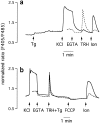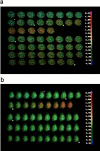Dynamic properties of an inositol 1,4,5-trisphosphate- and thapsigargin-insensitive calcium pool in mammalian cell lines
- PMID: 9015306
- PMCID: PMC2134824
- DOI: 10.1083/jcb.136.2.355
Dynamic properties of an inositol 1,4,5-trisphosphate- and thapsigargin-insensitive calcium pool in mammalian cell lines
Abstract
The functional characteristics of a nonacidic, inositol 1,4,5-trisphosphate- and thapsigargin-insensitive Ca2+ pool have been characterized in mammalian cells derived from the rat pituitary gland (GH3, GC, and GH3B6), the adrenal tissue (PC12), and mast cells (RBL-1). This Ca2+ pool is released into the cytoplasm by the Ca2+ ionophores ionomycin or A23187 after the discharge of the inositol 1,4,5-trisphosphate-sensitive store with an agonist coupled to phospholipase C activation and/or thapsigargin. The amount of Ca2+ trapped within this pool increased significantly after a prolonged elevation of intracellular Ca2+ concentration elicited by activation of Ca2+ influx. This pool was affected neither by caffeine-ryanodine nor by mitochondrial uncouplers. Probing mitochondrial Ca2+ with recombinant aequorin confirmed that this pool did not coincide with mitochondria, whereas its homogeneous distribution across the cytosol, as revealed by confocal microscopy, and its insensitivity to brefeldin A make localization within the Golgi complex unlikely. A proton gradient as the driving mechanism for Ca2+ uptake was excluded since ionomycin is inefficient in releasing Ca2+ from acidic pools and Ca2+ accumulation/release in/from this store was unaffected by monensin or NH4Cl, drugs known to collapse organelle acidic pH gradients. Ca2+ sequestration inside this pool, thus, may occur through a low-affinity, high-capacity Ca2+-ATPase system, which is, however, distinct from classical endosarcoplasmic reticulum Ca2+-ATPases. The cytological nature and functional role of this Ca2+ storage compartment are discussed.
Figures









Similar articles
-
Store-operated Ca2+ entry and coupling to Ca2+ pool depletion in thapsigargin-resistant cells.J Biol Chem. 1997 Mar 7;272(10):6440-7. doi: 10.1074/jbc.272.10.6440. J Biol Chem. 1997. PMID: 9045668
-
Thapsigargin-sensitive Ca(2+)-ATPases account for Ca2+ uptake to inositol 1,4,5-trisphosphate-sensitive and caffeine-sensitive Ca2+ stores in adrenal chromaffin cells.Biochem J. 1995 May 1;307 ( Pt 3)(Pt 3):749-58. doi: 10.1042/bj3070749. Biochem J. 1995. PMID: 7741706 Free PMC article.
-
Ca2+ entry in gonadotrophs and alpha T3-1 cells: does store-dependent Ca2+ influx mediate gonadotrophin-releasing hormone action?J Endocrinol. 1996 Apr;149(1):155-69. doi: 10.1677/joe.0.1490155. J Endocrinol. 1996. PMID: 8676048
-
[Mechanism of activation of receptor-operated calcium entry in non-excitable cells].Nihon Yakurigaku Zasshi. 1991 Jun;97(6):319-27. doi: 10.1254/fpj.97.6_319. Nihon Yakurigaku Zasshi. 1991. PMID: 1651891 Review. Japanese.
-
Intracellular compartmentation of organelles and gradients of low molecular weight species.Int Rev Cytol. 2000;192:223-53. doi: 10.1016/s0074-7696(08)60528-8. Int Rev Cytol. 2000. PMID: 10553281 Review.
Cited by
-
Oligopeptidase B-dependent signaling mediates host cell invasion by Trypanosoma cruzi.EMBO J. 1998 Sep 1;17(17):4975-86. doi: 10.1093/emboj/17.17.4975. EMBO J. 1998. PMID: 9724634 Free PMC article.
-
Overexpression of calsequestrin in L6 myoblasts: formation of endoplasmic reticulum subdomains and their evolution into discrete vacuoles where aggregates of the protein are specifically accumulated.Mol Biol Cell. 1997 Sep;8(9):1789-803. doi: 10.1091/mbc.8.9.1789. Mol Biol Cell. 1997. PMID: 9307974 Free PMC article.
-
FAD-linked Presenilin-1 V97L mutation impede tranport regulation and intracellular Ca(2+) homeostasis under ER stress.Int J Clin Exp Med. 2015 Nov 15;8(11):20742-50. eCollection 2015. Int J Clin Exp Med. 2015. PMID: 26884997 Free PMC article.
-
Defective platelet function in Niemann-Pick disease type C1.JIMD Rep. 2020 Sep 12;56(1):46-57. doi: 10.1002/jmd2.12148. eCollection 2020 Nov. JIMD Rep. 2020. PMID: 33204596 Free PMC article.
-
Endoplasmic reticulum Ca2+-ATPase pump is up-regulated in calcium-transporting dental enamel cells: a non-housekeeping role for SERCA2b.Biochem J. 2001 Aug 15;358(Pt 1):217-24. doi: 10.1042/0264-6021:3580217. Biochem J. 2001. PMID: 11485570 Free PMC article.
References
-
- Amundson J, Clapham D. Calcium waves. Curr Opin Neurobiol. 1993;3:375–382. - PubMed
-
- Bastianutto C, Clementi E, Codazzi F, Podini P, De Giorgi F, Rizzuto R, Meldolesi J, Pozzan T. Overexpression of calreticulin increases the Ca2+ capacity of rapidly exchanging Ca2+stores and reveals aspects of their lumenal microenvironment and function. J Cell Biol. 1995;130:847–855. - PMC - PubMed
-
- Bian J, Ghosh TK, Wang JC, Gill DL. Identification of intracellular calcium pools. Selective modification by thapsigargin. J Biol Chem. 1991;266:8801–8806. - PubMed
-
- Bobe R, Bredoux R, Wuytack F, Quarck R, Kovacs T, Papp B, Corvazier E, Magnier C, Enouf J. The rat platelet 97-kDa Ca2+ATPase isoform is the sarcoendoplasmic reticulum Ca2+ATPase 3 protein. J Biol Chem. 1994;269:1417–1424. - PubMed
Publication types
MeSH terms
Substances
Grants and funding
LinkOut - more resources
Full Text Sources
Miscellaneous

